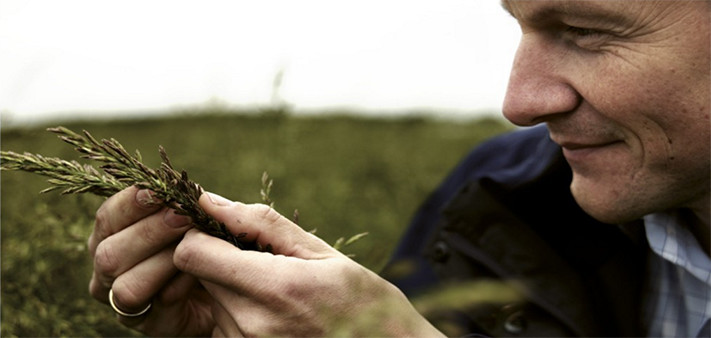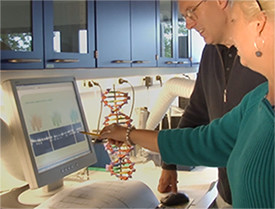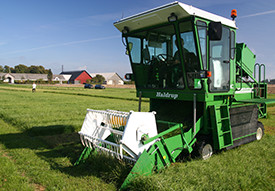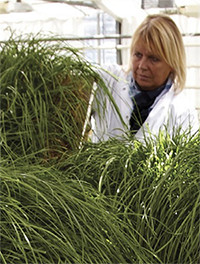
Genomic selection – the science of super-grasses
We all want more from our grasses – increased yield, improved quality, better stress tolerance, stronger disease resistance – and all at once. Now the dream of better-at-everything super-grasses could be within sight thanks to genomic selection.
20/01/2016
Genomic selection will improve forage and milk yields
Decades of research have taught our science teams that the simultaneous boosting of grass-seed traits – yield, quality, stress tolerance, disease resistance – is hugely difficult. What researchers need is a recipe book for those traits. Luckily there is such a thing, and it lies within the ryegrass genome, which essentially is a reference book on how to make a good forage grass.
Genomic selection unlocks the secrets of better grass
Our research teams are now using information drawn from the ryegrass genome to generate breeding gains in diploid – and soon in tetraploid – ryegrass. The technique is called genomic selection (GS), and it lets us choose grass varieties on the basis of their genetic potential. Previously we were guided purely by agronomical data gathered from field trials.
 To determine the genomic potential of a grass, we have to work out which sections of the genome control each trait. We do this by comparing the genomes from thousands of breeding lines and matching them with the traits that we want to improve. If we can find elements of DNA that are shared by, for example, high yielding varieties, we should know which sections of genetic code determine high yield. It's the same with disease resistance or drought tolerance.
To determine the genomic potential of a grass, we have to work out which sections of the genome control each trait. We do this by comparing the genomes from thousands of breeding lines and matching them with the traits that we want to improve. If we can find elements of DNA that are shared by, for example, high yielding varieties, we should know which sections of genetic code determine high yield. It's the same with disease resistance or drought tolerance.
Once we know enough about the genome, we should be able to predict the performance of a new breeding line. Analysis of ryegrass has so far given us 1,8 million DNA markers. Although that equates to just 1% of the entire genome, it is more than enough for us to make some solid genomic predictions.
Five years of development
The project began five years ago, when we and scientists at Aarhus University in Denmark decided to develop GS for grass breeding. Although much was already known from GS in cattle, there were neither statistical methods nor any DNA recipe technologies for grasses which, in contrast to cattle, are bred as families.
 Our starting point was a seed catalogue covering an entire decade of breeding activities. Using this data we identified almost 1800 ryegrass families – all with historic field data – from which we could extract DNA to create a marker recipe for each family.
Our starting point was a seed catalogue covering an entire decade of breeding activities. Using this data we identified almost 1800 ryegrass families – all with historic field data – from which we could extract DNA to create a marker recipe for each family.
At the same time our breeders and scientists began to trial all the families again, and to add a number of extra traits for future selections. It was an immense task, involving thousands of extra yield plots, rust scorings, and chemical analyses for fibre and sugar content. But it was worth the effort. From 2015, GS became a standard procedure in forage ryegrass breeding at DLF.
GS is now standard practice
Today, we use GS to preselect new seed lines for various traits before we put them through field trials. In the future, we might drop the three-year trial period and go straight to new variety formation. This will cut development time from 11 to eight years.
Farmers will soon see the benefits of GS. For several decades, the annual breeding gains in dry-matter yield remained constant at around 0.2%. With GS, we expect the annual gain to more than double. For other traits, the gains may be even higher as selection pressure has historically concentrated on yield.
Could GS reduce methane emissions?
 After using GS to identify the most promising offspring, the next step is to isolate the best matched parents. We are already doing this in a new project which also includes the development of prediction models for efficient nitrogen use. The overall objective is to increase yield gains even further and increase forage digestibility to reduce methane emission from meat and dairy production.
After using GS to identify the most promising offspring, the next step is to isolate the best matched parents. We are already doing this in a new project which also includes the development of prediction models for efficient nitrogen use. The overall objective is to increase yield gains even further and increase forage digestibility to reduce methane emission from meat and dairy production.
Project partn
ers include DLF, Aarhus University, and Tystoftefonden, which will conduct most of the nitrogen trials. The project receives financial support from The Ministry of Environment and Food (GUDP), and runs until 2019. If you'd like to know more, you can follow the project at www.forageselect.com. Or watch out for further developments in future issues of ForageMax®.

